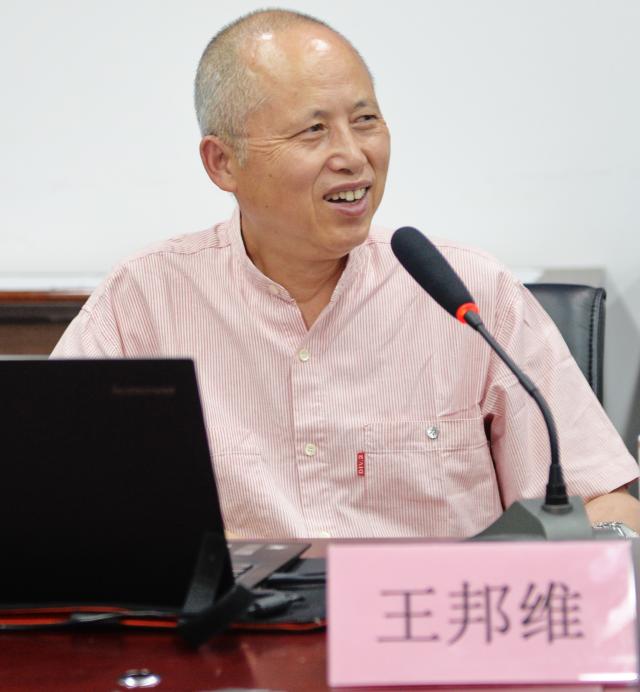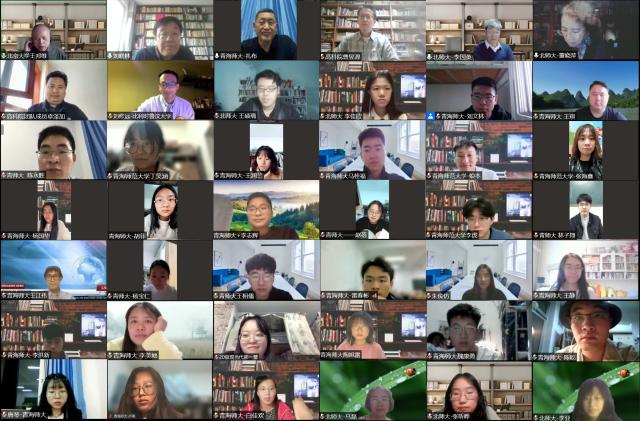青海师范大学中国语言文学一级学科研究生通识课程
“跨文化中国学研究方法论”第五讲
王邦维教授《“烈士无言”与“生死之梦”:
一个故事的文学及文化解读》

主讲教授简介:王邦维,北京大学博雅讲席教授,我国著名佛教史、东方学、中印交流史研究专家。季羡林先生培养的我国第一位印度语言文学专业博士。英国剑桥大学、美国哈佛大学、德国哥廷根大学留学、高访和工作。印度比哈尔邦那烂陀大学董事会成员。北京大学东方学研究院院长、北京大学印度研究中心主任。教育部人文社科重点研究基地北京大学东方文学研究中心首任主任。曾任国务院学位委员会第五届和第六届学科评议组外国语言文学组成员。王邦维教授著述自上世纪80年代起已产生了较大的国际影响,获国际级和国内奖项的主要有:与季羡林先生等合注《大唐西域记校注》获陆文星、韩素音中印友谊奖(1987)和国家图书奖一等奖(1993)。个人学术专著《大唐西域求法高僧传校注》获陆文星、韩素音中印友谊奖(1985),《南海寄归内法传校注》获北京市第四届哲学社会科学优秀成果一等奖(1996)和教育部全国高等学校第二届人文社科研究优秀成果三等奖(1998),《跨文化的想象:文献、神话与历史》获中版好书奖(2019)和社科优秀图书奖(2020)。在国内以及德国、法国、印度、日本、瑞典、爱沙尼亚、尼泊尔、美国、荷兰、丹麦出版有各类学术著作和发表学术论文多篇。其新著《佛教史话六讲》是支持“教育援青”人文学科基础建设的又一力作。
2022年4月9日,青海师范大学中国语言文学一级学科“跨文化中国学研究方法论”研究生课开始第五讲,由北京大学王邦维教授担任主讲,题目为《“烈士无言”与“生死之梦”:一个故事的文学及文化解读》。由于疫情管理的原因,本次授课仍采用远程网络教学方式进行,在西宁和北京两地实时同步上课。青海师范大学文学院,青海师范大学民族师范学院、青海师范大学高原科学与可持续发展研究院、北京师范大学跨文化研究院师生、欧洲高校研究生70余人线上听讲。青海师大文学院2021和2022级学术型研究生全部参加听讲。青海师范大学文学院副院长刘晓林教授主持本课。
王邦维教授此讲所使用的文本是《大唐西域记》卷第七《五国》中的《烈士池》。《大唐西域记》闻名于世,佛教史、佛典文学、历史学、印度学、东方学和海外汉学等多学科领域都表现出对它的浓厚兴趣。上世纪八十年代,北京大学季羡林先生率弟子王邦维教授等完成校注《大唐西域记》,将国际性研究与中国化研究相结合,获国家图书奖一等奖,是在国际学界发出的中国声音的代表。关于《烈士池》的研究,王教授也发表过系列文章。在本课中,他从跨文化学的视角切入,以《烈士池》为个案,提出新见。
一、跨文化研究的资料系统
王邦维教授研究《烈士池》建立了严密的资料系统,分三层:一是以玄奘《大唐西域记》为祖本;二是以唐代相关文献为重点,包括同时期玄奘在印度搜集的佛教经卷与其他文献,以及唐代《烈士池》故事的续写文本;三是相关中印文化交流史资料,覆盖面所及,大体有我国西部青藏高原地区和毗邻国家印度、巴基斯坦、阿富汗和乌兹别克斯坦等。由资料系统可见,《烈士池》是小入口,跨文化资源大海洋,有了系统的资料储备,才能从一个点上遥望星辰大海。
二、跨文化的文学分析
王教授研究《烈士池》的方法是回归文本。他一段一段地举述《烈士池》的原文,讲解其原句和原意,从文本本身分析这个富有传奇色彩的故事。他指出,“烈士”在印度的原意是指刚烈之士,要求禁言缄口,不说话,与今天中国人的理解不同。但这个故事走出印度后变化很大,在不同的国家、 地区和民族中流传,情节、结构和思想内涵都有差异。
在中国,玄奘所处的唐代是一个开放的时代,唐人十分乐于吸收玄奘从印度带回来的故事,这样我们就能看到,直到今天,唐代的《烈士池》衍生文本也是最多的。比较出名的有:唐段成式《酉阳杂俎》、唐牛僧孺《玄怪录》和唐薛渔思《河东记》。后世还有宋李昉《太平广记》和明冯梦龙《醒世恒言》中的再写本。南亚和东亚国家对它也很热衷,日本作家芥川龙之介将之改编为小说《杜子春》。当代还有类似故事流传,北京大学几年前上演过话剧《杜子春》,据说还有《杜子春》的动漫。王教授指出,唐代资料是一个分界线,在唐人笔记《玄怪录》和《河东记》中,人物、情节和结构的发展都已相当丰满,两位作者工于叙事,技艺娴熟,把“烈士”和道士的形象塑造得栩栩如生,达到相当中国化的程度。
王邦维教授的研究意见是,也不能因为《烈士池》已在一些国家具有本地的流行性,这种现象还比较多见,就断定它的前世今生。为什么今天要研究《烈士池》?原因不仅仅在于它来自印度,还要考虑怎样解释它的文学价值?王教授的聚焦点是,《烈士池》是印度故事,但《大唐西域记》的作者是中国高僧唐玄奘。唐玄奘把印度故事收入自己的中文书中,介绍给印度以外的国家,当然主要是中国,这就产生了跨文化之举。此文本在中国产生了连锁反应,结果对中国古代文学史而不是佛教史产生了变革作用,对这种“跨”来的转变就要进行研究,要点有二:1)一个印度故事,经过跨地理、跨历史、跨社会的流传,在“烈士”的概念上产生了变化,孱入了新的含义,而概念的变化就是一个点,需要聚焦;2)印度故事连环成套,这种形态中国过去没有。唐代以后才有,应该说,印度故事的输入,促进了中国故事线性叙事向连环体形式的转变,我国后来出现的章回连环小说已在《烈士池》中初具大端。
三、跨文化的文化解读
什么是跨文化研究的文化价值?这是王邦维教授此课的又一个重点,他在研究目标和方法也值得注意。他认为,印度文本被他者记录和解读的结果,未必代表印度人原来的想法。玄奘在《大唐西域记》中谈到的现象和所作的解释,其实印度人也未必都那么想。玄奘久居印度,也与印度高僧有很多辩论和交流,深得印度高僧的认可,但这不等于文化同化。一个关键问题是,玄奘记载的《烈士池》就不是佛经故事,而是一个在印度当地流传的故事,但这个故事流传到中国,增加了佛教色彩,如轮回观念;也增加了道家思想,如《河东记》对“萧洞玄(道士)”和“终无为(烈士)”的塑造。还有,所有中国文本都否定出世,肯定入世,宣扬的是儒家“亲亲”的伦理价值观。此外,历代文人学士用力着墨于“慎无言”,是否具有哲学思辨的倾向?追求大化无言、大音希声的至高境界?也不妨从这个方向多少做一些思考。上述中国思想成分都是原来印度故事中所没有的。
王教授还指出,跨文化研究要注意跨民族性。我国西部青藏高原地区和印度、巴基斯坦、阿富汗、乌兹别克斯坦等毗邻国家,还有另一种类似“无言”主题的故事文本,如印度古代梵文故事集《僵尸鬼故事二十五则》和在我国西藏和青海地区流传的《尸语故事》。这类故事都有“不说话”能带来好品德或好结果的训诫。把这类故事与《烈士池》的故事合起来看,能看到文化多样性,也能看到会“跨”的故事独具特征。王邦维教授的讲课要言不烦、抽丝剥茧,实证细密而气象博大。在不知不觉中,带领师生穿越历史的文本,进入理论的胜境。跨文化研究的文化价值,就在于找到这种文化转场。文化转场是跨文化研究的核心概念兼方法。王教授的授课正是一次跨文化研究目标和方法的生动演示,深入浅出而思想深邃。三个小时的授课倏忽而逝,大家仍然意犹未尽。

王邦维教授《“烈士无言”与“生死之梦”:一个故事的文学及文化解读》授课现场(2022年4月9日)
青海师范大学文学院副院长刘晓林教授做了课程总结,他高度评价王邦维教授的治学将传统与创新结合、将实证与理论结合,体系博大,厚积薄发。青海师范大学民族师范学院藏语文研究专家吉太加教授热情地回应说,在青海藏族人民的精神世界中,《尸语故事》占有不同寻常的重要位置。在他的家乡青海贵德县,藏民家庭的老人世世代代给孩子讲《尸语故事》,藏民以这种传统方式教育人们恪守戒律,积德行善。民族师范学院的藏族青年学者卓泽加副教授说,《大唐西域记》在青海和西藏地区影响也很大,近年还出版了公贡布加译本、工布查布译本和次仁顿珠译本等一批藏文译著。多民族语言文本可以拓展《大唐西域记》的研究空间,促进内地高校与西部高校的学术交流。
Postgraduate General Course of the First-Level Discipline
Chinese Language and Literature of Qinghai Normal University
“Methodology of Transcultural Study on Chinese Society and Culture” Invites
Professor Wang Bangwei to Deliver Lecture on:
“The Silence of Hero” and “The Dream of Life and Death”:
The Literary and Cultural Interpretation of a Story
On April 9th, 2022, the fifth lecture of “Methodology of Transcultural Study on Chinese Society and Culture”, postgraduate general course of the first-level discipline Chinese Language and Literature of Qinghai Normal University, was delivered online by Professor Wang Bangwei from Peking University. The title of his lecture is: “The Silence of Hero” and “The Dream of Life and Death”: The Literary and Cultural Interpretation of a Story. Due to the impact of COVID-19, this lecture was still conducted by remote network teaching, with real-time synchronous classes in Xining and Beijing. More than 70 participants attended the lecture online, including postgraduates and teachers from College of Chinese Language and Literature of Qinghai Normal University, Teachers College for Nationalities of Qinghai Normal University, Academy of Plateau Science and Sustainability of Qinghai Normal University, College of Transcultural Studies of Beijing Normal University, and European Universities. Academic type of postgraduate students from College of Chinese Language and Literature of Qinghai Normal University enrolled in 2021 and 2022 attended the lecture. Professor Liu Xiaolin, vice dean of College of Chinese Language and Literature, QNU, presided over the lecture.
The texts used by Professor Wang Bangwei were excerpts from Hero’s Pond (or Life-saving Pond) from Five Countries, the seventh volume of The Great Tang Dynasty Record of the Western Regions. The team of professors Ji Xianlin and Wang Bangwei from Peking University conducted long-term research on The Great Tang Dynasty Record of the Western Regions and achieved important results, winning the first prize of the National Book Award of China. In this lecture, Professor Wang Bangwei made a transcultural study of Hero’s Pond and put forward a new interpretation.
I. Transcultural Resource System
Professor Wang Bangwei’s research on Hero’s Pond is based on a rigorous system with fertile historical resources, which can be divided into three levels: first, basic resources from The Great Tang Dynasty Record of the Western Regions. Second, important resources from historical documents of Tang Dynasty as well as Buddhist scriptures collected by Xuanzang in India at that time. Third, relevant historical materials of cultural exchange between China and India.
II. Transcultural Literary Analysis
Returning to the text is the method used in the study of Hero’s Pond by Professor Wang Bangwei. He pointed out that the Indian “Hero”, originally referring to silent martyr, is very different from the way Chinese people understand this word today. After this story moved out of India, it changed a lot in different countries, regions and ethnic groups, generating various variations. Tang Dynasty was an open era. Scholars of Tang Dynasty were very willing to absorb the stories Xuanzang brought back from India. Hero’s Pond had the largest number of variations in Tang Dynasty, such as Youyang Za Zu by Duan Chengshi, Xuan Guai Lu by Niu Sengru and He Dong Ji by Xue Yusi. Later generations also had such stories in Records of the Taiping Era compiled by Li Fang in Song Dynasty and Stories to Awaken the World by Feng Menglong in Ming Dynasty. Japanese author Ryunosuke Akutagawa published an adapted novel called Du Zichun. A new play Du Zichun was staged at Peking University a few years ago. It is said that there has been a cartoon version of Du Zichun. According to Professor Wang Bangwei, Xuan Guai Lu and He Dong Ji developed Hero’s Pond adequately, reaching a considerable degree of Chinese style.
There is an important point of view from Professor Wang Bangwei. According to him, previous or present life of a story cannot be concluded arbitrarily just because this story is popular locally in different countries and the phenomenon is relatively common. Hero’s Pond is an ancient Indian story. Why do people study it today? The reason is not just that it is an Indian story. We focus on the fact that Hero’s Pond is an Indian story, but the author of The Great Tang Dynasty Record of the Western Regions is a Chinese man, Xuanzang. He took Indian stories into his Chinese books and introduced them to other countries outside India, mainly China of course. In doing so, Xuanzang made a remarkable transcultural move which had a transformative effect on the history of ancient Chinese literature rather than the history of Buddhism. There are three main points: 1) The transfer of the concept of “hero” occurred through the spread of Indian legends across geography, history and society. 2) The literary thinking, structure and thematic pattern of Indian stories were integrated, which did not exist in China until Tang Dynasty. The import of such Indian works helped to transform the genre of Chinese fiction.
III. Transcultural Cultural Interpretation
What is the cultural research value of transcultural texts? This is another important point of Professor Wang Bangwei’s lecture. He also made the noteworthy point that certain Indian texts which were handed down to people of other countries for interpretation did not represent what the Indians originally thought. He emphasized that Xuanzang’s cognition of the Indian scriptures and his interpretation of Indian myths and legends in The Great Tang Dynasty Record of the Western Regions were not necessarily what Indians thought. Xuanzang, who lived in India for a long time, was recognized by Indian eminent monks and had many debates and exchanges with them, but this did not amount to cultural assimilation. Hero’s Pond is not a Buddhist story, but in the process of Chinese people’s acceptance of this story, it gradually has Buddhist colors, such as the concept of reincarnation, and Confucian thoughts, such as the idea that men are better than women, and the metaphor of men turning to women. There are also Taoist thoughts in it, such as the portrayal of “Xiao Dong Xuan” and the notion of “ultimately doing nothing”.
Anyway, most of the “hero” narratives in China deny “out of the world” and affirm “into the world”. Choosing the Confucian values is regarded as a cultural transition. In addition, whether the so-called “prudent silence” has the tendency of philosophical speculation can also be examined from this perspective.
